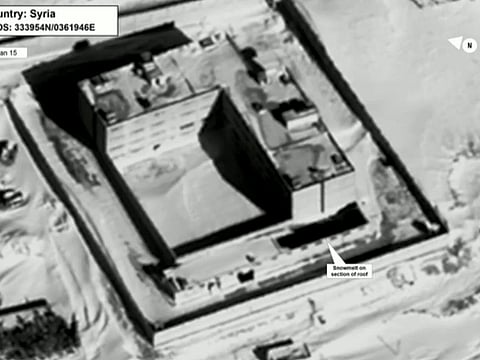Haunting image of Al Assad 'crematorium'
US accuses Syrian regime of converting prison into makeshift facility for burning thousands of bodies

Washington: The United States on Monday accused the Syrian regime of installing a prison crematorium to destroy the remains of thousands of murdered detainees, piling pressure on Russia to rein in its ally.
Warning Moscow it should not turn a blind eye to Bashar Al Assad’s crimes, the State Department released satellite images that it said backed up reports of mass killings at a Syrian jail.
“The United States is on record, has stated many times, that we are appalled by the atrocities that have been carried out by the Syrian regime,” said Stuart Jones, the top US diplomat for the Middle East.
“And these atrocities have been carried out seemingly with the unconditional support from Russia and Iran.”
And he added a warning to President Vladimir Putin’s government: “Russia must now, with great urgency, exercise its influence over the Syrian regime to guarantee that horrific violations stop now.”
One newly released image, a commercial satellite photograph dating back to January 2015, shows snow melting on the roof of a building attached to the Saydnaya military complex north of Damascus.
This, along with an earlier picture allegedly showing heavy-duty ventilation systems on the structure, appear to support earlier claims by rights groups that Saydnaya is an execution centre.
‘Cover up’
“Beginning in 2013, the Syrian regime modified a building within the Saydnaya complex to support what we believe is a crematorium,” said Jones, currently an acting assistant secretary of state.
“Although the regime’s many atrocities are well documented, we believe that the building of a crematorium is an effort to cover up the extent of the mass murders taking place in Saydnaya.”
Jones said Washington’s information came from credible humanitarian agencies and from the US “intelligence community” — implying that classified evidence beyond the commercial pictures exists.
“The regime holds as many as 70 prisoners in Saydnaya in cells that have a five-person capacity,” Jones alleged.
“And according to multiple sources, the regime is responsible for killing as many as 50 detainees per day at Saydnaya.”
He did not give an official estimate for the total number killed, but cited an Amnesty International report that between 5,000 and 11,000 had died between 2011 and 2015 in the prison.
Al Assad’s regime, he alleged, has detained between 65,000 and 117,000 people over the same period — the first five years of a civil war that has left hundreds of thousands dead.
One satellite photograph presented by Jones dated to January 2015, more than two years ago, and it was not immediately clear why the United States waited to present its evidence.
Jones told reporters Secretary of State Rex Tillerson had raised concerns about Al Assad’s brutality with Russia’s Foreign Minister Sergei Lavrov during his visit to Washington last week.
Sarin attack
Moscow, along with Iran, is the Al Assad regime’s main foreign backer and Washington believes Russian pressure is the only thing that will compel its ally to negotiate a peace deal.
“I would say that this information has been developing,” Jones said on the timing of the crematorium allegation.
Jones said Washington is not specifically accusing Moscow or Tehran of complicity in the alleged Saydnaya killings, but said Russia is aware of and has supported other abuses.
And he said last week’s visit by Lavrov to the White House was “an opportune time to remind people about the atrocities that are being carried out inside of Syria all the time.”
US President Donald Trump came to office vowing to focus US efforts in Syria on defeating Daesh in the east of the country.
And he said he hoped to work with Putin, whose forces are in Syria to protect Al Assad’s regime, in this goal.
But relations with Moscow, already dire under Trump’s predecessor Barack Obama, have not improved and Al Assad has continued to bombard civilian areas in his battle with opposition rebels.
Then last month, when Al Assad was again accused of using the banned nerve agent sarin in a strike on his own people, Trump ordered a retaliatory US cruise missile strike on a Syrian air base.
Sign up for the Daily Briefing
Get the latest news and updates straight to your inbox



